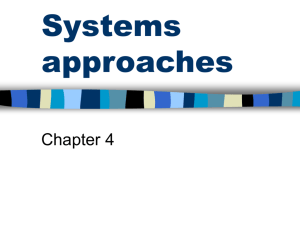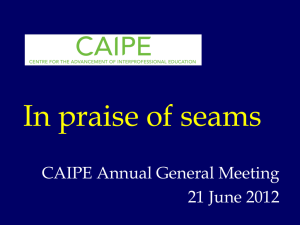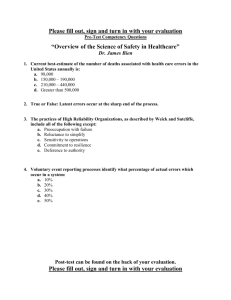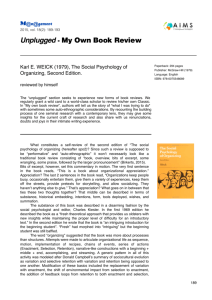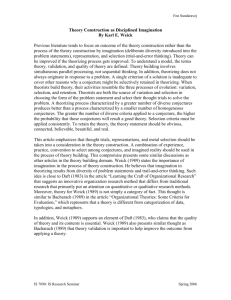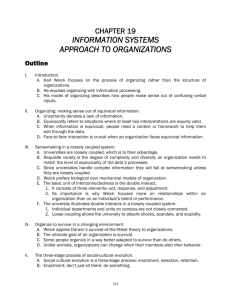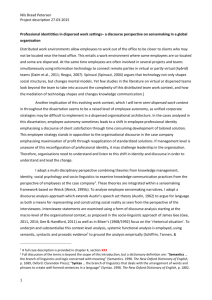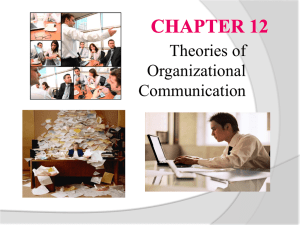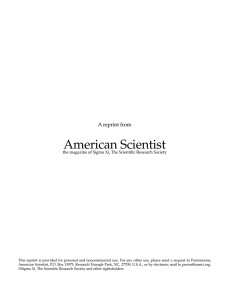Organizational Information Theory: Weick's Approach
advertisement
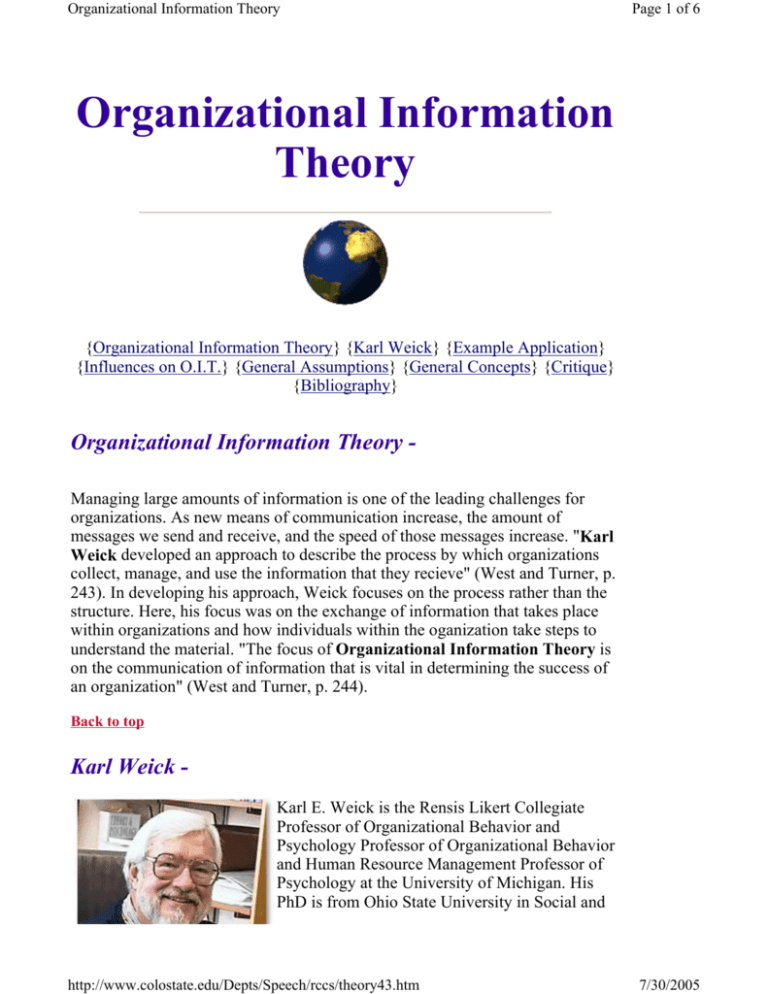
Organizational Information Theory
Page 1 of 6
Organizational Information
Theory
{Organizational Information Theory} {Karl Weick} {Example Application}
{Influences on O.I.T.} {General Assumptions} {General Concepts} {Critique}
{Bibliography}
Organizational Information Theory Managing large amounts of information is one of the leading challenges for
organizations. As new means of communication increase, the amount of
messages we send and receive, and the speed of those messages increase. "Karl
Weick developed an approach to describe the process by which organizations
collect, manage, and use the information that they recieve" (West and Turner, p.
243). In developing his approach, Weick focuses on the process rather than the
structure. Here, his focus was on the exchange of information that takes place
within organizations and how individuals within the oganization take steps to
understand the material. "The focus of Organizational Information Theory is
on the communication of information that is vital in determining the success of
an organization" (West and Turner, p. 244).
Back to top
Karl Weick Karl E. Weick is the Rensis Likert Collegiate
Professor of Organizational Behavior and
Psychology Professor of Organizational Behavior
and Human Resource Management Professor of
Psychology at the University of Michigan. His
PhD is from Ohio State University in Social and
http://www.colostate.edu/Depts/Speech/rccs/theory43.htm
7/30/2005
Organizational Information Theory
Page 2 of 6
Organizational Psychology. Dr. Weick's Book The Social Psychology of
Organizing, first published in 1969 and revised in 1979, was declared one of the
nine best business books ever written by Inc Magazine in December of 1996.
The organizing formulation has more recently been expanded into a book titled
Sensemaking in Organizations. Dr. Weick's research interests include collective
sensemaking under pressure, medical errors, hand-offs in extreme events, high
reliability performance, improvisation, and continuous change. Dr. Weicks
graduate level teaching focuses on the social psychology of organizing, micro
foundations of organization studies, the craft of scholarship, and his executive
education teaching focuses on the management of uncertainty through
sensemaking and improvisation.
Back to top
Example Application Do you remember the Y2K scare? Companies and people world-wide who
depended on computers were in a state of panic when they learned that their
computers might not be compatible in the new millenium. NowBank was one of
these companies. An associate named Dominique Martin was to head up
operations for a Y2K conversion. However, the company had branches in
Denver, Dallas, and also Phoenix. By way of videoconferencing, all teams
would meet to discuss each branch's responsibilities. Upon meeting, many
different areas of management began to arise. Areas such as providing updates,
maintaining communication between all branches, and keeping their own
division running made the operation stressful. As concerns began to escalate,
Dominique realized that effective communication would be key to the success
of the project. To manage all of the concerns, problems, and communication
issues the team implemented aspects of Organizational Information Theory.
With communication as the highest priority, NowBank was successful in their
conversion. The company continues to run smooth.
Back to top
Influences on O.I.T. In Weick's first book The Social Psychology of Organizing, he presents "his
theoretical approach explaining how organizations make sense of and use
information" (1969). Weick states, "Organizations and their environments
change so rapidly that it is unrealistic to show what they are like now, because
that's not the way they are going to be later" (1969, p.1). However, Weick
realized that complete knowledge could not come from one source. There must
be other influences on communication and also relationships among individuals.
Two other theories were explored.
http://www.colostate.edu/Depts/Speech/rccs/theory43.htm
7/30/2005
Organizational Information Theory
z
z
Page 3 of 6
General System Theory
Darwin's Theory of Evolution
General System Theory
Weick applied Ludwig von
Bertalanffy's (pictured here) General
System Theory in developing his
approach to examine how organizations
manage their information. In order to
make neccessary adjustments to reach a
common goal, an organization must
depend on combined information.
Bertalanffy notes, "While in the past,
science tried to explain observable
phenomena by reducing them to an
interplay of elementary units
investigatable independantly of each
other, conceptions appear in contemporary science that are concerned with what
is somewhat vaguely termed "wholeness," i.e., problems of organizations.
General System Theory, therefore, is the general science of
"wholeness" (Bertalanffy, pp. 36 - 37).
Back to top
Darwin's Theory of Evolution
Weick also used another theory to describe the "process by
which organizations collect and make sense out of
information" (West and Turner, p. 245). This process is
Charles Darwin's (pictured here) Theory of Sociocultural
Evolution. Originally, the theory of evolution described
the "adaptation process that organisms undergo to thrive in
a challenging ecological environment" (p. 246). This was
when the term was coined, "survival of the fittest." The
theory later describes the "changes that people make in
their social behaviors and expectations in order to adapt in
their social surroundings" (p. 246). "Weick adapts the
theory of sociocultural evolution to explain the process
that organizations undergo in adjusting to various information
pressures" (p.246)."
http://www.colostate.edu/Depts/Speech/rccs/theory43.htm
7/30/2005
Organizational Information Theory
Page 4 of 6
Back to top
General Assumptions One way to explain the way in which organizations make sense out of
information that may be ambiguous or confusing is Organizational Information
Theory. This theory focuses "on the process of organizing members of an
organization to manage information rather than on the structure of the
organization itself" (West and Turner, p. 246). There are assumptions beneath
Weick's Organizational Information Theory:
z
z
z
Human Organizations engage in information processing to reduce
equivocality of information
The information an organization receives differs in terms of equivocality
Human organizations exist in an information environment
Back to top
General Concepts Organizational Information Theory does include a significant number of
concepts that are crucial to fully understand this theory. They are: information
environment, information equivocality, and cycles of communication. Here is a
brief explanation of each one:
Information Environment "Information environment is a core concept in understanding how organizations
are formed as well as how they process information. Everyday, we are faced
with thousands of stimuli that we could potentially process and interpret. The
availability of all stimuli is consdered to be the information environment.
(West and Turner, p. 248).
Information Equivocality "Organizations receive information from multiple sources; They must decode
the information and determine whether it is comprehensible, which person or
department is most qualified to deal with the information, and whether multiple
departments require this information to accomplish their tasks. Without clarity
in these areas, there is information equivocality" (p. 248).
Cycles of Communication -
http://www.colostate.edu/Depts/Speech/rccs/theory43.htm
7/30/2005
Organizational Information Theory
Page 5 of 6
There are three steps to the cycle of communication. The three steps consist of
act, response, and adjustment. The act "refers to the communication behaviors
used to indicate one's ambiguity as a result of information that is received. The
reaction to the act indicating equivocality of information defines the concept of
response. A response of clarifying information is provided as a result of the act.
As a result of the response, the organization formulates a response in return as a
result of any adjustment that has been made to the information that was
originally received. An adjustment is made to indicate that the information is
now understood" (p. 252).
Back to top
Critique In thoroughly studying this theory, I find that Organizational Information
Theory plays a very prevalent role in organizational communication. We have
come to such a day where communication is critical to our personal lives, our
social lives, and also our professional lives. I believe this theory has no
limitations within organizational communication. It addresses aspects of the
individual and also the group within the organization. Organizational
Information Theory is a valuable theory to study and also practice.
Back to top
Bibliography Bertalanffy, L., General System Theory. New York: George Braziller, Inc.
1968.
Dixon, T., Communication, Organization, and Performance. New Jersey:
Ablex Publishing Corporation 1996.
Goldhaber, G., Organizational Communication Sixth Edition . Madison,
Dubuque, Indianapolis, Melbourne, Oxford: Brown & Benchmark
Publishers 1974, 1993.
Putnam, L., and Pacanowsky, M., "An Interpretive Approach."
Communication and Organizations. Beverly Hills, New Delhi, and London:
Sage Publications, Inc. 1993.
Weick, K.
http://webuser.bus.umich.edu/departments/OBHRM/faculty/weick/bio.html
http://www.colostate.edu/Depts/Speech/rccs/theory43.htm
7/30/2005
Organizational Information Theory
Page 6 of 6
Weick, K., The social psychology of organizing. Reading: Addison-Wesley
1969.
West, R., and Turner, L., Introducing Communication Theory: Analysis
and Application. Mountain View: Mayfield Publishing Co. 2000.
Back to top
Web Author: Michael Gadachy
Date Published: 11/12/01
http://www.colostate.edu/Depts/Speech/rccs/theory43.htm
7/30/2005
